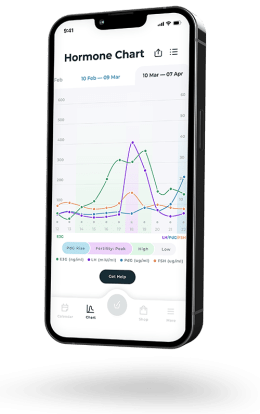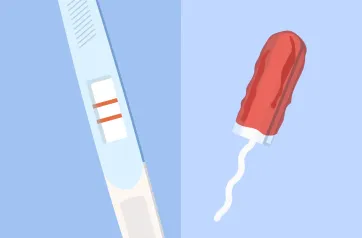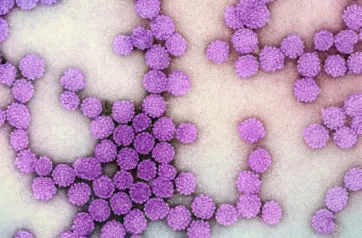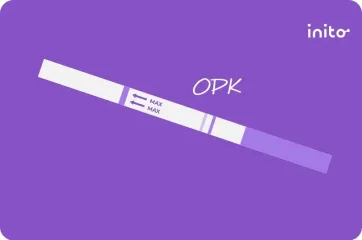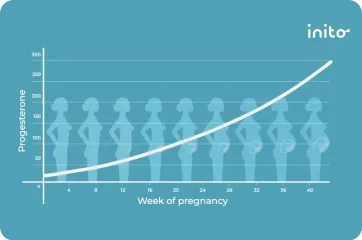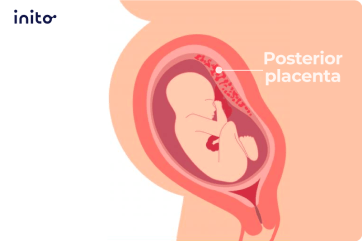Content table
If your periods are irregular, you may not be ovulating. But a no LH surge on an ovulation test does not mean that you haven’t ovulated.
Ovulation Predictor Kits (OPKs) check for the Luteinizing Hormone (LH). Known as “LH” for short, the luteinizing hormone is a potent fertility predictor.
Although they may give you a negative result, there’s more to it than meets the eye.
Understanding the LH surge is essential if you’re trying to get pregnant. Also, tracking your hormones can help with natural family planning.
This blog explains the science behind LH changes and helps you understand how they affect your menstrual cycle.
Key Takeaways
- LH hormone helps regulate your menstrual cycle and activates the ovary to release a mature egg (ovulation).
- Every woman and every cycle is different; some may have two or more LH surges each month.
- If your LH levels do not rise from the baseline, then you won’t ovulate that cycle.
- If you do not ovulate, you cannot get pregnant.
- Women who do not have an LH surge should talk with a doctor to rule out any serious problems.
How Does LH Trigger Ovulation?
Luteinizing hormone (LH), produced by the pituitary gland, is a sex hormone involved in reproduction. In women, LH plays two important roles.
- Helps regulate your menstrual cycle.
- Activates the ovary to release a mature egg (ovulation) in your monthly cycle.
Fun fact: men also produce the luteinizing hormone. The hormone causes the testes to make testosterone in males, which is important for sperm production.
LH level stays about the same throughout a woman’s menstrual cycle — except when you are about to ovulate. This happens during your follicular phase, which begins the first day of your period and ends when you ovulate.
Let’s break down the timing of when LH rises next…
When LH Hormone Levels Rise?
LH levels spike around 24 to 36 hours before ovulation. It’s called an “LH Surge.” This rapid rise in hormones affects your ovaries in a few ways:
- It causes the ovaries to push the follicles that hold the eggs to change.
- Ovarian follicles start to swell.
- The outer follicular membrane begins to break down.
- The egg is released as part of the ovulation process.
In most women, these changes from the LH surge typically occur around 12-14 days before the next menstrual period. Still, every woman is different. Even your cycle can vary slightly from month to month.
So, Does No LH Surge Mean No Ovulation?
As you see, when LH level surges, it’s a signal that your ovaries may release an egg soon.
But that raises another question: Does no LH surge mean no ovulation?
You need an LH rise to cause the follicle to rupture and release the egg.
An LH surge tells the body it’s time to release a mature ovum (egg).
So, what if you have a low LH surge?
If there is a surge, albeit minimal, from the baseline levels of LH, that is enough for your follicle to rupture and release the egg.
Studies have shown that an average LH surge is a 7.7-fold increase from the baseline. But a range of 2.5 to 14.8-fold increase from the baseline in LH levels can bring about ovulation.
You can have an otherwise normal monthly cycle (period) and not ovulate. And you may not even know it! Unless, of course, you are monitoring your hormone levels.
In that case, a follicular cyst develops because the ovarian follicle (sac) continues to grow without releasing an egg. Over time, the cyst usually goes away on its own.
Read more: Do Ovarian Cysts Lower Your Chances of Pregnancy?
What Is a Normal LH Range?
Let’s understand the normal range of LH in your urine throughout your cycle.
Period Phase | LH Level |
Follicular Phase | 3 – 5 mIU/ml |
Luteal Phase | 3 – 5 mIU/ml |
LH Surge | 25 – 100 mIU/ml |
To identify a true surge in LH, you must monitor your levels over a full cycle. It can be tricky because LH levels can rise more than once during the month. Here’s how.
What Are the Main Types of LH Surge?
Single or “Spike” pattern
Approximately 41.9% of cycles fall into this pattern. In this scenario, the LH level peaks and then returns to its baseline.
Biphasic pattern
Interestingly, more women tend to have this type of LH surge (about 44.2%). In a biphasic LH surge, the hormone level rises and falls. But then it rises a second time before falling back to its baseline. The two peaks may be equal, or one could be higher. Two LH surges do not mean that you will ovulate twice. You usually ovulate after the second LH surge.
Plateau pattern
Around 13.9% of cycles demonstrate a plateau pattern. In this type of surge, LH goes up and remains at a peak level for 2–3 days before dropping back to baseline. Some research suggests that a sustained peak over 2–3 days increases the chances of pregnancy.
Some women can also experience multiple surges, meaning they have more than two peaks in a cycle. Still, this is rare.
Keep in mind that every person and each cycle is unique. Hence, levels can vary significantly. Tracking your hormone levels will give you a better idea of what’s happening in your body.
Now, if you test your LH levels on a regular OPK, you may not get accurate results.
Most OPKs rely on your average threshold levels to detect LH. If you don’t fall within this average range, you may get false results.
Read More: How to Read a Positive Ovulation Test?

See how your hormone chart might look like!
Answer some questions to help us provide you a free personalized hormone chart customized to your hormonal health and conditions
What happens if you don't have an LH surge?
If you don’t have an LH surge, you won’t ovulate. This is because the surge of LH is what triggers the follicle to release a mature egg. Having no LH surge now and then is no reason to be concerned. Even women with generally normal cycles experience anovulatory cycles every so often. But if you consistently don’t have an LH surge or you have irregular LH patterns, this could impact your fertility.
Why is my LH surge not detected?
There are a few reasons your LH surge may not be detected:
- Reason 1: Your baseline LH levels are lower than average. This means that even though your LH levels rise and trigger ovulation, they may not reach the threshold value that your ovulation test is able to detect.
- Reason 2: Your LH surge pattern and how often you’re testing. If you have a rapid LH surge and you only test once a day, it’s possible for you to miss detecting the surge. Also, if you have a very irregular cycle, it can also make the timing of testing tricky to get right for LH surge detection.
- Reason 3: Not following the test directions properly. It’s important to follow the instructions on the ovulation test to a tee. Check the manufacturer’s guidelines on how to use the test strips to avoid experiencing faulty results.
- Reason 4: You don’t have an LH surge. There could be an underlying condition affecting your hormones that’s causing you not to have an LH surge. If this is constantly happening, you’ll want to check in with your healthcare provider.
Why am I getting high fertility but no peak?
If you are getting High Fertility but no Peak Fertility, it means your LH levels have not yet risen from your baseline levels. This isn’t unusual and can occasionally happen. Keep testing to catch your Peak Fertility.
Note: High Fertility begins when your estrogen levels start rising from the dominant follicle maturing and getting ready to be released. This is generally 3-4 days before you ovulate. Peak Fertility happens when your LH levels surge (about 24-36 hours before you ovulate).
Why is my body not producing LH?
Several underlying factors can affect your body’s ability to produce LH. These include high levels of stress, over-exercising, insufficient nutrition, or a condition that affects your pituitary gland. If you’re experiencing issues with your LH levels, talk to your doctor so you can get to the root cause.
What stimulates LH release?
Your LH release and ovulation are part of a larger sequence of events initiated by your reproductive hormones. The two main hormones that trigger your LH levels to rise are estrogen and gonadotropin-releasing hormone (GnRH).
Here’s what happens:
- When your dominant follicle reaches a certain size, it releases estrogen.
- This rise in estrogen signals to your hypothalamus that it’s time for ovulation.
- GnRH from your hypothalamus then tells your pituitary gland to stop producing FSH and start releasing LH.
What time of day does LH peak?
The exact time of day that your LH will peak can vary. But for many women, LH tends to be at its highest between midnight and early in the morning. Keep in mind also that some women have shorter-lived LH peaks than others. So if you’re using OPKs, it’s a good idea to test once in the morning and once in the afternoon to make sure you don’t miss detecting it.
What are the symptoms of low luteinizing hormone?
Some of the symptoms you could experience if you have low LH are:
- Anovulation
- Irregular or absent periods
- Infertility
- Low sex drive (since LH impacts your testosterone levels)
- Fatigue or poor muscle strength
Can you get pregnant if LH is low?
Yes, it is still possible to get pregnant with low LH. What’s more important than the exact value of your LH is the difference between your baseline LH levels and your surge. If your LH levels are able to rise above your baseline level, it could be enough to trigger ovulation. And if you’re ovulating, pregnancy is possible.
That said, if your LH levels aren’t rising enough to trigger ovulation, it’s a good idea to check in with your doctor or a fertility specialist. They can help you pinpoint why your LH levels are low and help you figure out a plan for getting your LH back on track.
Was this article helpful?
- Characteristics of the urinary luteinizing hormone surge in young ovulatory women – Fertility and Sterility
- Detection of ovulation, a review of currently available methods – PMC
- Follicle Cyst – an overview | ScienceDirect Topics
- Luteinizing Hormone (LH) Levels Test: MedlinePlus Medical Test
- Luteinizing Hormone: Reference Range, Interpretation, Collection and Panels
- Menstrual Cycle – an overview | ScienceDirect Topics
- Onset of the preovulatory luteinizing hormone surge: diurnal timing and critical follicular prerequisites
- Physiology, Ovulation – StatPearls – NCBI Bookshelf
- The Normal Menstrual Cycle and the Control of Ovulation – Endotext – NCBI Bookshelf
- The pattern of the luteinizing hormone surge in spontaneous cycles
- Urinary Luteinizing Hormone Tests: Which Concentration Threshold Best Predicts Ovulation? – PMC
{ “@context”: “https://schema.org”, “@type”: “FAQPage”, “@id”: “https://blog.inito.com/when-is-the-best-time-to-take-an-ovulation-test/#faq”, “mainEntity”: [ { “@type”: “Question”, “name”: “When is the best time of day to use an ovulation test?”, “acceptedAnswer”: { “@type”: “Answer”, “text”: “The best time of day to take an ovulation test would be once in the morning with your first morning urine (FMU) and once in the afternoon. This will give you the best chance of capturing and detecting your LH surge in the event that you have a short-lived single spike pattern.\n\nIf you’re only able to test once a day though, go with your first morning urine. This is because LH surge levels tend to be highest between the hours of midnight and 8am.” } }, { “@type”: “Question”, “name”: “Why is my ovulation test positive in the morning and negative at night?”, “acceptedAnswer”: { “@type”: “Answer”, “text”: “The most likely reason for having a positive ovulation test in the morning and a negative one at night has to do with your LH surge pattern. Some women have a rapid onset LH surge that rises and falls within a matter of hours. If you have this type of surge pattern and see a positive result in the morning, it’s perfectly normal to get a negative result hours later when you test in the evening.\n\nThe more you track your typical LH patterns (with ovulation tests or a fertility monitor like Inito), the more you’ll get to know what’s “normal” for you.” } }, { “@type”: “Question”, “name”: “Is it better to take an ovulation test once or twice a day?”, “acceptedAnswer”: { “@type”: “Answer”, “text”: “Determining if it’s better to take an ovulation once or twice a day depends on what’s most important to you. If your top priority is being able to detect and avoid potentially missing your LH surge, twice a day is better. That said, we know that having to buy more ovulation test strips can add up monetarily over time. So if you want to make ovulation testing more financially sustainable, then once a day, first thing in the morning may be a better option.” } }, { “@type”: “Question”, “name”: “Do two lines on an ovulation test mean pregnant?”, “acceptedAnswer”: { “@type”: “Answer”, “text”: “In some cases, two lines on an ovulation test could mean that you’re pregnant. This is because the molecular makeup of LH and hCG are similar and sometimes the test can’t tell the difference.\n\nThat said, if you have a fairly regular cycle and you’re taking an ovulation test mid-cycle, the two lines aren’t likely to indicate a pregnancy. This is because your hCG levels wouldn’t begin rising until after implantation (6 – 12 DPO) which is likely a full week or more after you would be using LH test strips.” } }, { “@type”: “Question”, “name”: “Can I have a negative ovulation test but still ovulate?”, “acceptedAnswer”: { “@type”: “Answer”, “text”: “Yes, you can have a negative ovulation test and still ovulate. This is because home ovulation tests are designed around average LH levels and thresholds. But natural baseline LH levels differ quite a bit from one woman to the next. This means that a woman who has a lower baseline LH level could still experience an LH surge that triggers ovulation, but the LH wouldn’t be high enough for a test to detect.\n\nFor most ovulation predictor kits, the threshold value for a positive result is around 20 – 25 mIU/mL. So let’s say there are two women. Woman A has a baseline LH level of 3 and Woman B has a baseline LH level of 14. Woman A’s LH surge peaks at 15 mIU/mL and Woman B’s LH surge peaks at 65 mIU/mL. Both women may ovulate, but Woman A’s ovulation test would be negative while Woman B’s would be positive.” } }, { “@type”: “Question”, “name”: “Do ovulation tests get darker after 5 minutes?”, “acceptedAnswer”: { “@type”: “Answer”, “text”: “It is possible for ovulation tests to get darker after 5 minutes, depending on the brand of test you’re using and the environmental conditions you’re in (like extra moisture in the air).\n\nSometimes, an evaporation line can develop on your test as well. This happens when the test is left sitting out for too long. The urine evaporates, leaving behind salts that form a faint line on the test. This shouldn’t be taken as a positive test, and you should never judge your ovulation test results off of a result that appears outside of the test window. You can find the specific test window timing on the manufacturer’s directions for the test you’re using.” } }, { “@type”: “Question”, “name”: “Why am I not ovulating but having periods?”, “acceptedAnswer”: { “@type”: “Answer”, “text”: “When you’re not ovulating but still having periods, it’s not really considered a true period. Instead, it’s called anovulatory bleeding, and it’s caused by hormonal imbalances. With this type of bleeding, it will usually happen at less predictable times, and it may be heavier or longer-lasting than true period bleeding.” } }, { “@type”: “Question”, “name”: “What does weak ovulation mean?”, “acceptedAnswer”: { “@type”: “Answer”, “text”: “Weak ovulation could mean that something has gone wrong with the timing of ovulation and your hormonal response. This isn’t a medically recognized diagnosis, though.\n\nWeak ovulation is linked with lower levels of progesterone (a hormone that is vital for implantation and early pregnancy) or a shorter luteal phase.” } } ] }








